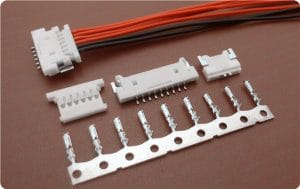How do you use DuPont wires?

How do you use DuPont wires?
DuPont wires are also known as Jumper cables because of their working nature. These are simple wires that have connector pins at both ends. This unique feature makes them useful as a connector without using external soldering. The manufacturer of the connection type they install, both male and female ends, gave them this name.
DuPont wires are affordable cables and are used extensively with sensors, Arduino boards, and other breadboards to make it easy to change a circuit as needed. Male to Male, Male to Female, and Female to Female cable are all available from DuPont. They are much easier to recognize inside a prototype (typically a tangle of wires) and may be categorized by function since they have various colours such as red, yellow, black, blue, and green.
The distinction between DuPont wires lies in the wire’s termination point. Male ends have a protruding pin and get plugged into objects, but female ends do not have a projecting pin and plugs into things. Male-to-male jumper wires are the most popular and the ones you’ll most likely utilize. A male-to-male DuPont wire connects two ports on a breadboard.
What makes DuPont unique?
DuPont cables are used for internal wiring in office equipment, audio and video machines, electrical projects, and authentic Arduino devices. They’re long-lasting and reusable, as well as easy to set up and utilize.
Even though jumper wires exist in a variety of colors, the colors have no meaning. It means that a red jumper wire is the same as a black jumper wire. Colors distinguish between different types of connections, such as ground and power, which further eases their usage.
Each wire in the DuPont ribbon cable is self-contained and does not exert any significant force on its neighbors. You can divide them or use bigger connectors to link many wires together as needed.
DuPont wires are so simple that many experts recommend making your cables rather than buying them from the market or online. Making DuPont cables is an easy task, and with the right tools in hand, it is just a matter of minutes to create one.
Using DuPont Wires
The majority of DuPont wires are 28 AWG. It indicates that the maximum current allowed is about 1 Amp. Even if they appear to be 28 AWG, many DuPont cables, particularly those made in China, are not. Just in case, you might use two or three of them in parallel.
The male end of the wire is frequently not encased in the same plastic DuPont blank connectors as the female header, but instead is just wrapped with a black sheath cylindrical. Even though both sorts are available, there is a distinction between them that must be considered.
Using wires with a DuPont male end would be ideal. It is because these single-channel connections are ideal for mounting in parallel to accommodate numerous female connectors (such as those found on Arduino), and only those with the DuPont casing square can be put correctly side by side.
In contrast to most housings, the housings are also quite straightforward to get contacts in and out of. You can easily remove the single housings and replace them with a 3-pin housing if you want to convert from individual jumpers to ones with a 3-pin housing for connecting to a sensor.
DuPont wires in Sensors
Sensors are utilized in nearly every industry. Sensors add a new dimension to your project in a variety of ways. There are several types of sensors that can record various kinds of data. Every sensor works uniquely. The technique of connecting these sensors to a microcontroller is made possible with DuPont wires. Home security sensors are highly effective in preventing burglary.
When connecting boards or distant sensors, 3 pin jumper cables are usually handy. Basic digital sensors, 1-wire protocols, analog sensors, and any other 3 pin connection you need to establish are all possible using the 3 pin format.
DuPont Connector
A DuPont connector is a colloquial phrase that refers to a variety of 0.1′ pitch connectors. They have black plastic housings with fingers integrated into the housing body to maintain contact. Although they all have a similar appearance, the quality and pricing of each differ substantially.
These are perfect for building circuits between your microcontroller and the breadboard on the bots, a 3D printer. Reusable for quickly creating an electrical circuit prototype. Soldering isn’t necessary. This is the most used form of the cable wire. Wires are adaptable, reusable, traceable, and simple to join and disengage.
The parting words
Automotive applications have the highest need for novel connection designs and materials. Connectors must work in harsh environments, such as high temperatures and corrosive chemicals. In the automobile sector, which is transitioning to solderless press-fit connections, single and multi-insertion connectors are required. DuPont wires are rapidly becoming a sought-after commodity in the market.
DuPont cables can be produced at home, but if not, you can get them online and continue with your experiments and discoveries. We live in a technological age; make the most of it.






